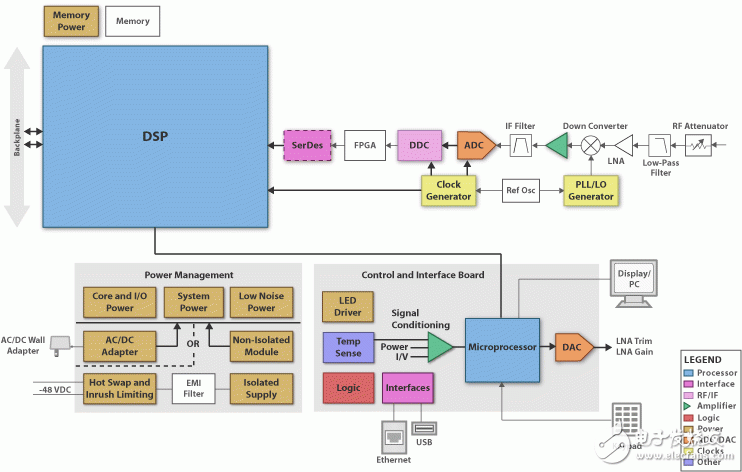The block diagram (SBD) combines superheterodyne technology with a high-speed analog-to-digital converter (ADC) and digital signal processor (DSP) to perform spectral measurements, demodulation, and time domain analysis of the modulated signal.
Design considerations
The Vector Signal Analyzer (VSA) combines traditional superheterodyne technology with modern high-speed analog-to-digital converters (ADCs) and digital signal processors (DSPs) to perform spectrum measurements, demodulation, and time-varying systems and complex modulated signals. Time domain analysis. These features make the VSA an ideal instrument for communications, radar/sound, video, and many other applications.

Common subsystems include:
RF front end
After amplification or attenuation and filtering, the RF input signal is downconverted to an intermediate frequency (IF) at one or more frequency conversion levels. The main specifications include phase noise and jitter.
IF section
The commercial availability of ultra-high speed ADCs has been instrumental in the emergence of vector signal analyzer series instruments. The main specifications for these ADCs include bandwidth, dynamic range, and signal-to-noise ratio.
Digital signal processing
Various signal analysis functions can be implemented in software running on top of the DSP. The software enables the VSA to describe complex modulation and time-varying signals in terms of spectrum, modulation, and waveform analysis. The input to the DSP-based software is sampled by I/Q vector modulated signals generated by different wireless and wireline communication standards. The receive chain is implemented in the DSP, including modulation/demodulation, channel decoding, MIMO processing, equalization, and multi-pass fading compensation. Typical analysis functions include swept spectrum analysis, wideband FFT signal analysis, and high speed continuous measurements (including CCDF, power spectral density, autocorrelation, and compliance measurements). It also enables standards-based modulation analysis, vector signal generation, and burst error rate (BER) measurements. The inherent benefits of software implementation include the quick and easy implementation of new features, the revision of existing features, and the support of multiple standards and technologies. TI's DSP architecture enables ultra-high code efficiency and fast execution of mathematically intensive signal processing algorithms that are applicable to all complex communication standards. With an ultra-fast C64x+ core, TI DSPs have additional performance enhancements such as extensive internal memory, multiple high-speed I/Os, and high-speed external memory interfaces for processing large amounts of sampled data.
Power management and conversion
Vector signal analyzers come in a variety of shapes, such as desktop, portable, and modular (or backplane based). The shape plays an important role in determining the power management requirements of the instrument. For example, many desktop VSAs are based on a computer architecture that facilitates the use of various display, interface, and power management features on the PC market. Other VSAs for field service applications can be powered by batteries. Texas Instruments offers power management solutions for every available instrument form factor.
100W Wall Pack Lights,Wall Pack Light Fixture,Wall Pack Light 100W,Led Wall Pack Light 140Lm/W
Vietnam JJ Lighting Company , https://www.vnjjlighting.com